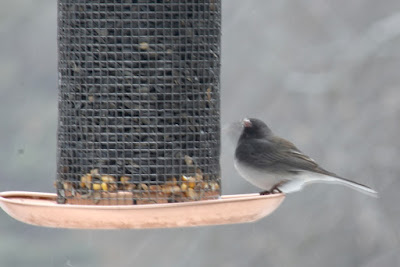Smaller, shallower ponds are now ice covered. Some snow has melted, but snow and ice remain, covering much of the driveway and the fields behind the house. Perhaps more significantly, dark-eyed juncos have arrived. In fact, they've been hopping around the deck for several days now. Yet another sign that Winter is settling in.
 |
| dark-eyed junco at feeder
Photo by J. Harrington
|
This morning a small flock of four hen turkeys gathered under the pear tree. Last night several whitetail deer scampered through the far fields around the large spruce trees. Flocks of starlings have been seen taking flight from roadside shoulders and ditches. Local farmers still have some fields of both soy beans and corn to be harvested. If next week's thaw and return to seasonal temperatures doesn't turn the fields to mud, perhaps this year's harvest can be completed this year instead of next.
The shapes and forms that life takes are simply astounding, if we slow down enough to just think about it. Life / nature / evolution are all ongoing experiments, variations on themes. Societies and cultures are probably also like that, efforts to discover what works better under which circumstances for whom. We are but one member of the hominids and might well be advised to remember that a number of other members of the family are no longer in existence. Starting to think about today's politics in such a context has helped me understand how so many voters in the US can support an unqualified, untrained, incompetent individual for one of the most powerful positions in the world. As Ralph Waldo Emerson has noted, "All life is an experiment. The more experiments you make the better." As our own history, and that of the only world we know, has shown us, not all experiments are successful. Not all survive. When, outside of Jurassic Park, was the last time you saw a live dinosaur? So, if you haven't yet, please go vote for those who offer a viable future for the rest of US. You know, those who are creating a future instead of a return to a non-viable past. Those who support life more than death. Your descendants will thank you.
How, Alan Turing thought, does the soft-walled,
jellied, symmetrical cell
become the asymmetrical horse? It was just before dusk,
the sun’s last shafts doubling the fence posts,
all the dark mares on their dark shadows. It was just
after Schrodinger’s What is Life,
not long before Watson, Franklin, Crick, not long before
supper. How does a chemical soup,
he asked, give rise to a biological pattern? And how
does a pattern shift, an outer ear
gradually slough its fur, or a shorebird’s stubby beak
sharpen toward the trout?
He was halfway between the War’s last enigmas
and the cyanide apple—two bites—
that would kill him. Halfway along the taut wires
that hummed between crime
and pardon, indecency and privacy. How do solutions,
chemical, personal, stable, unstable,
harden into shapes? And how do shapes break?
What slips a micro-fissure
across a lightless cell, until time and matter
double their easy bickering? God?
Chance? A chemical shudder? He was happy and not,
tired and not, humming a bit
with the fence wires. How does a germ split to a self?
And what is a—We are not our acts
and remembrances, Schrodinger wrote. Should something—
God, chance, a chemical shudder?—
sever us from all we have been, still it would not kill us.
It was just before dusk, his segment
of earth slowly ticking toward night. Like time, he thought,
we are almost erased by rotation,
as the dark, symmetrical planet lifts its asymmetrical cargo
up to the sunset: horses, ryegrass—
In no case, then, is there a loss of personal existence to
deplore—
marten, whitethroat, blackbird,
lark—nor will there ever be.
********************************************
Thanks for visiting. Come again when you can.
Please be kind to each other while you can.
No comments:
Post a Comment